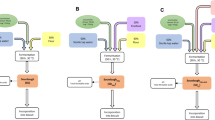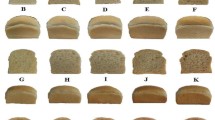Abstract
In three weekly tests in 2018, samples of raw sugar, refinery liquor and refined sugar were collected from a Tucuman sugar factory/back-end refinery and analyzed for starch, polysaccharides, proteins and silicates. The standard 10-day acid floc behavior, which is a sample being either floc positive or floc negative, was correlated against the levels of the four impurities. Of these impurities, starch had statistically the most significant effect on floc formation, both in the refined sugar set as well as in the raw sugar/refinery liquor set of samples. Despite the use of some α-amylase at the mill, the starch levels in refined sugar were relatively high. The effects of polysaccharides, proteins and silicates on floc formation were statistically less significant, although the proteins were on average higher in floc-positive than in floc-negative sugars.


Similar content being viewed by others
References
APHA. 2005. Standard methods for the examination of water and wastewater. 21st Edition: 4/164-4/168.American Public Health Association, Washington.
Bradford, M. 1976. A rapid and sensitive method for the quantitation of microgram quantities of protein utilizing the principle of protein dye binding. Annals of Biochemistry 72: 248.
Foong, K.K., R. Amal, W.O.S. Doherty, and L.A. Edye. 2002. A review on acid beverage floc. Zuckerindustrie 127: 382–388.
ICUMSA. 2017. Method GS 2/3-40 2017. International commission for uniform methods of sugar analysis method book. Bartens, Berlin.
Naidoo, S., and R. Simpson. 2004. The detection of protein in refined sugar. Proceedings of the South African Sugar Technologists’ Association 78: 569–572.
Ranucci Lemos, L., A. Noguiera, G. Wosiacki, L.G. Lacerda, and I. Mottin Demiate. 2013. The influence of different amounts of dextran and starch in crystallized sugar in the formation of floc in acidic carbonated solutions and alcoholic solutions. Sugar Tech 15: 65–70.
Ruiz, M., M. Sastre Siladji, M. Coronel, S. Zossi, O. Diez, and M. Saska. 2013. Determination and causes of the acid beverage floc in cane sugar. Proceedings of the International Society of Sugar Cane Technologists 28: 1886–1896.
Ruiz, M., M. Sastre Siladji, M. Coronel, S. Zossi, O. Diez, and M. Saska. 2016. Floc de bebidas ácidas en azúcar blanco del noroeste de Argentina. Revista industrial y agrícola de Tucumán 93 (2): 27–33.
Saska, M., M. Ruiz, S. Zossi, and M. Sastre. 2013. Some comments on the colorimetric determination of silicate in cane sugar. International Sugar Journal 115 (1380): 852–857.
Saska, M., S. Zossi, M. Sastre Siladji, R. Torres, and M. Ruiz. 2016. Modifications to the Roberts’ method for total soluble polysaccharides in refined and raw cane sugars. Proceedings of the International Society of Sugar Cane Technologists 29: 354–361.
Acknowledgments
Cooperation and help of the management and staff of the Leales sugar factory are greatly appreciated, as is the continued support for EEAOC sugar factory programs from the entire Tucuman sugar industry. Special thanks also to Santiago Ostengo and Dr. Ana Sfer for their help with the statistical evaluation of the data.
Author information
Authors and Affiliations
Corresponding author
Additional information
Publisher's Note
Springer Nature remains neutral with regard to jurisdictional claims in published maps and institutional affiliations.
Appendix
Appendix
Rights and permissions
About this article
Cite this article
Sastre Siladji, M., Saska, M., Zossi, S. et al. Effects of Starch, Polysaccharides, Protein and Silicate on the Formation of Acid Beverage Floc in Refined Sugar. Sugar Tech 22, 727–733 (2020). https://doi.org/10.1007/s12355-020-00820-3
Received:
Accepted:
Published:
Issue Date:
DOI: https://doi.org/10.1007/s12355-020-00820-3




